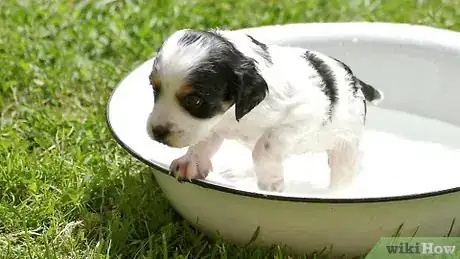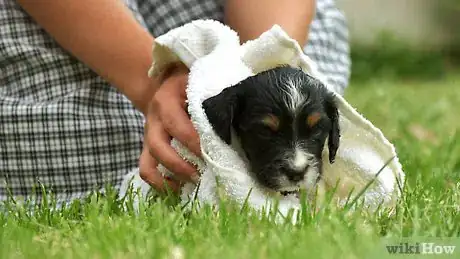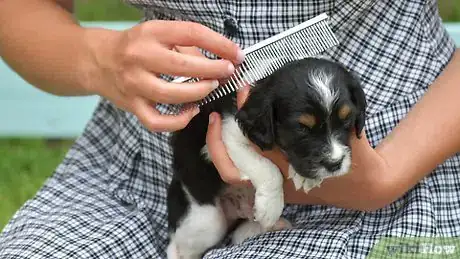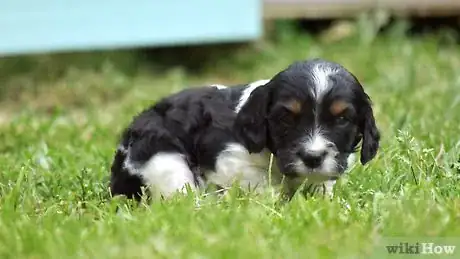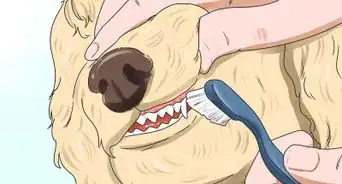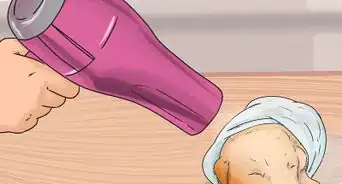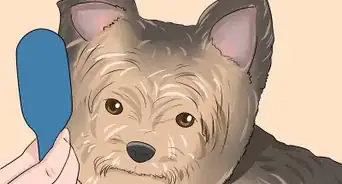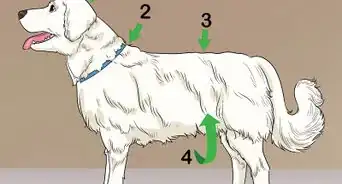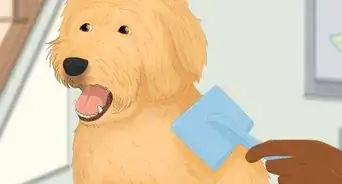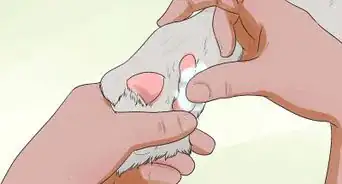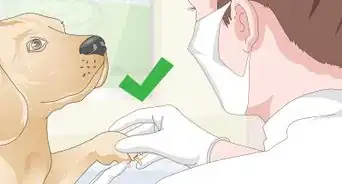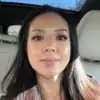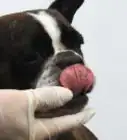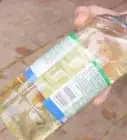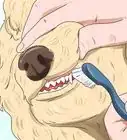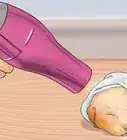This article was co-authored by Marie Lin. Marie Lin is a Licensed Pet Groomer and the Owner of Marie's Pet Grooming, a grooming salon based in New York City. Marie has over 10 years of pet grooming experience specializing in dogs and cats. She earned her pet grooming certification from the American Academy of Pet Grooming New York in 2009 and is also a member of the National Dog Groomers Association of America. She earned a Master of Business Administration (MBA) from Hawaii Pacific University in 2007.
This article has been viewed 28,942 times.
Grooming a puppy yourself can seem like a daunting task and it can, in fact, be a bit tricky. However, it also offers the opportunity to bond with your pup and establish good habits for your little canine friend. Regular grooming not only keeps your puppy looking and smelling clean, it is important for detection of possible infestations or medical problems. If you decide not to utilize a professional groomer’s services for your puppy, there are techniques you can use at home to make the process go more smoothly and enjoyably for both of you.
Steps
Preparing for Grooming
-
1Start early. You may still hear advice circulating that you shouldn’t groom — and especially bathe — your puppy before it is six months old, but modern professional advice is to start easing into the grooming/bathing process as soon as possible.
- By starting the process early, your puppy can be ready for a full grooming session by sixteen weeks of age, about the time when its regimen of puppy shots will be complete.
-
2Associate grooming with fun. A puppy that is terrified at the prospect of a bath or cowers at the sight of a brush or nail clippers is never going to be a dog that makes grooming easy or fun.
- Provide treats and rewards early and often as you prepare your puppy for the grooming process. Reward as you begin a practice session, and during and after each step of the process — holding, handling feet, ears, etc., putting brush to fur, and so on.
- Practice holding your puppy still — gently but firmly. Do not respond when it squirms, but immediately release and reward it when it stops resisting. Teach that relaxation is rewarded, resistance is not.
- If your puppy learns the simple equation “grooming = treats” early on, it will be a more agreeable participant in the process for life.
Advertisement -
3Conduct several dry runs. Don’t introduce your puppy to grooming by yanking out knots with a brush then dunking the little guy into a tub. Instead, introduce the elements of each step in the process slowly, gently, and with plenty of encouragement and rewarding.[1]
- Let your puppy examine and sniff the brush before you use it. Start by gently applying the brush to fur for no more than two minutes, then give a reward. Repeat the process several times a day, slowly increasing the brushing sessions.
- Handle and touch sensitive areas, like paws and ears, for several days before attempting to groom them. Allow your pup to become familiar with the sensation of contact in these areas.
- Touch nails with the clippers before actually trying to cut them, and try the same with scissors on fur. After about five days of simple contact, you can slowly begin to do actual grooming tasks.
-
4Establish a routine. Introducing consistency to the grooming process allows your puppy to immediately recognize and respond accordingly. Just as a dog that hates baths will immediately respond negatively to any sign that one is imminent, a puppy that has learned to like them will react with excitement.
- Play with your puppy for several minutes before any grooming session. This not only introduces the routine, it also helps wear out your little basket full of energy before grooming.
- Establish a consistent location for grooming — a mat in the bathroom, a table in the kitchen, wherever it may be. A quiet, comfortable location will work best.[2]
-
5Be gentle and patient. This is essential advice for puppy care, in general, and is especially true when it comes to grooming. Expect some squirming, yelping, nipping, splashed water, scattered fur, and a few messes on the floor along the way.
- If grooming proves to be too much of a challenge for you and your pup, there is no shame in utilizing a professional groomer. The price you pay will be well worth not damaging the developing relationship between you and your new dog.
Grooming Your Puppy
-
1Brush with care. No single brush type, brushing technique, or brushing frequency is right for every dog. You can follow some specific advice by breed/fur type/size group, but expect to go through some trial and error.
- Long-haired puppies may need to be brushed daily and may require more specific tools like a slicker or pin brush while short-hairs may only need a quick weekly brushing with a simple comb or glove-brush. See How to Groom a Dog for more information of brush selection and brushing technique.
- Brush as much as needed, but always brush before giving a bath to remove knots and tangles.[3]
- Start with major parts of the body — back, sides, etc. — and work your way to more delicate or hard-to-reach areas as you go. Don’t yank out knots — use quick, firm strokes, and place your other hand on the skin or fur to counter the tugging effect.
- With puppies especially, remember to offer regular treats and constant praise during a brushing session.[4]
- Consult How to Brush Mats out of Dog Hair if you have a problem with severe tangles or matting, or see a groomer or your vet.
-
2Make bath time fun and cozy. Some puppies like getting wet, others despise it. By choosing a quiet, warm location and employing care and patience, you’ll increase your odds of ending up with a clean, happy dog (and less water splashed everywhere).[5]
- For most puppies, a sink or plastic basin is sufficient for a tub. Use only a few inches of water.
- Wet the fur thoroughly and use a shampoo specifically formulated for your dog's hair/fur type. Follow the instructions for application and rinsing.
- Do not, however, wet or use shampoo on the head or face. Even the gentlest shampoo can irritate a puppy's eyes, ears, and mouth. Lather up the rest of the body, including areas like armpits and the groin area, gently but thoroughly. Rinse until the water runs clear. Use a damp cloth without shampoo to clean the head and face, if needed.[6]
- Keep your puppy warm until it is completely dry, which can take up to 45 minutes, even with a good towel-drying.
- Advice varies widely on how often to bathe your dog — some say only a couple times per year,[7] others say weekly,[8] still others say simply whenever the dog is dirty. Modern shampoos have largely erased old fears of drying out the skin or hair, but feel free to consult your veterinarian or a groomer for advice on bathing frequency.
- Never use human shampoo, as it is too harsh for canine skin. Always use a mild dog shampoo. If in doubt, use a doggy oatmeal shampoo, which has mild moisturizing properties.
- See also How to Wash a Dog for more tips.
-
3Consider the haircut. For safety or just stylistic reasons, some people may feel better not attempting to cut their puppy’s hair. If so, employing a professional is a smart option.
- Though more expensive, dog clippers are usually safer and easier to handle for a novice than scissors. See How to Groom a Dog for advice on tools and techniques.
- Many puppies will respond well (and look fine) with a single-length “puppy cut". Consult general instructions for haircuts according to your dog’s breed and/or fur type.
- The best time for a haircut is after a bath, when the fur is about 75% dry. Be careful, obviously, but also remain calm and encouraging, and offer treats as you go.[9]
-
4Take the time to trim nails. Along with a haircut, trimming your dog’s nails may be the most worrisome aspect of the grooming process, because of your fear of causing injury. Regular nail-trimming, however, is important in preventing infections (via broken nails), toe malformation (due to overly-long nails), or unwanted scratches.
- How to Clip Dog Nails discusses nail clipper selection — either scissors-style or guillotine/cigar clipper style — and the use of styptic powder if you accidentally cut the "quick" within the nail and cause bleeding.
- Start slowly with a puppy, perhaps only trimming one or two nails per session, with regular treats and encouragement.
- Leaving nails a bit on the long side and having to trim more often is preferable to cutting them down to a nub and risking a pinch or cut, especially with a puppy. Clip off only a small amount at a time. Cutting into the quick and causing bleeding is not a pleasant experience for the puppy or you.
- Again, rely on a professional to do the trimming if you can’t or won’t, because it is important to do for your dog’s health. If your dog has an excessive fear of nail-trimming (or other fears/issues in general), consider bringing in a Certified Applied Animal Behaviorist (CAAB or ACAAB), Board Certified Veterinary Behaviorist (Dip ACVB), or Certified Professional Dog Trainer (CPDT).
-
5Check the eyes, ears, teeth, and skin. Remember, consistent grooming isn’t just about cleanliness. It can also help detect potential problems before they worsen.
- During a grooming session, visually examine and feel the skin for signs of fleas, ticks, or other parasites, and for unusual or unexplained marks or bumps. Consult your vet if concerned by any findings.
- It is normal for puppies to have discharge from the eyes. So long as there is not redness, puffiness, or a foul odor to the discharge, gently wipe it away with a damp cloth or cotton ball. Inspect the ears, but do not clean them out without your vet’s advice. Contact your vet if you find signs of redness, puffiness, or unusual discharge in either area.[10]
- Regular dental care is important in preventing puppy periodontal disease. You can buy doggie toothbrushes and toothpaste, or you can wipe the teeth with gauze or a soft cloth wrapped around your finger. Clean the teeth at least two or three times per week. Employ chew toys and teeth-cleaning treats regularly as well.[11]
Expert Q&A
Did you know you can get expert answers for this article?
Unlock expert answers by supporting wikiHow
-
QuestionHow can I groom my dog myself?
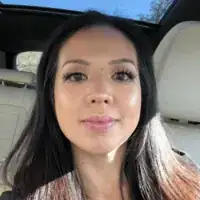 Marie LinMarie Lin is a Licensed Pet Groomer and the Owner of Marie's Pet Grooming, a grooming salon based in New York City. Marie has over 10 years of pet grooming experience specializing in dogs and cats. She earned her pet grooming certification from the American Academy of Pet Grooming New York in 2009 and is also a member of the National Dog Groomers Association of America. She earned a Master of Business Administration (MBA) from Hawaii Pacific University in 2007.
Marie LinMarie Lin is a Licensed Pet Groomer and the Owner of Marie's Pet Grooming, a grooming salon based in New York City. Marie has over 10 years of pet grooming experience specializing in dogs and cats. She earned her pet grooming certification from the American Academy of Pet Grooming New York in 2009 and is also a member of the National Dog Groomers Association of America. She earned a Master of Business Administration (MBA) from Hawaii Pacific University in 2007.
Licensed Pet Groomer Be patient, and be careful not to use sharp scissors around their face if you're not experienced. Grooming a puppy is challenging because they're highly energetic and they move around a lot more than adult dogs. Consider taking them to a professional groomer at least once to ensure that their first grooming experience is a positive one.
Be patient, and be careful not to use sharp scissors around their face if you're not experienced. Grooming a puppy is challenging because they're highly energetic and they move around a lot more than adult dogs. Consider taking them to a professional groomer at least once to ensure that their first grooming experience is a positive one. -
QuestionWhat do I do when my puppy doesn't want to eat her dog food?
 The ReplierCommunity AnswerThere might be something wrong with the food to the puppy. If after many tries, she doesn't eat it, then try another brand.
The ReplierCommunity AnswerThere might be something wrong with the food to the puppy. If after many tries, she doesn't eat it, then try another brand. -
QuestionIs it fine to bathe a dog when it's just familiarizing with the grooming process?
 Community AnswerBathing it every so often is good to get any dog at any age used to it, but it depends on the type of dog. If it doesn't need bathing, just groom it regularly.
Community AnswerBathing it every so often is good to get any dog at any age used to it, but it depends on the type of dog. If it doesn't need bathing, just groom it regularly.
References
- ↑ http://www.purina.co.uk/content/your-dog/helping-to-keep-your-dog-healthy/regular-dog-care/grooming-your-puppy
- ↑ http://www.purina.co.uk/content/your-dog/helping-to-keep-your-dog-healthy/regular-dog-care/grooming-your-puppy
- ↑ http://www.petsafe.net/learn/diy-dog-grooming-basics
- ↑ http://www.purina.co.uk/content/your-dog/helping-to-keep-your-dog-healthy/regular-dog-care/grooming-your-puppy
- ↑ http://www.purina.co.uk/content/your-dog/helping-to-keep-your-dog-healthy/regular-dog-care/grooming-your-puppy
- ↑ https://www.aspca.org/pet-care/virtual-pet-behaviorist/dog-behavior/bathing-your-dog
- ↑ http://www.purina.co.uk/content/your-dog/helping-to-keep-your-dog-healthy/regular-dog-care/grooming-your-puppy
- ↑ http://www.peteducation.com/article.cfm?c=2+2095&aid=824
- ↑ http://www.petsafe.net/learn/diy-dog-grooming-basics
About This Article
To get your puppy used to grooming, start grooming it as early as possible. Ideally, your puppy should be ready for a full grooming session by the time it’s 16 weeks old. Help it learn to enjoy grooming by offering rewards and treats before, during, and after each step of the process. Gradually introduce your puppy to grooming tools and procedures. For example, let your puppy sniff a new brush before using it, then brush its fur for no more than 2 minutes. As the puppy gets comfortable, increase your brushing time. It’s also helpful to establish a regular grooming routine. For example, pick a specific location, such as your bathroom, and have a quick play session there at the same time each day before you start grooming. Remember to be patient with your puppy! Read on to learn more details of the grooming process from our Veterinarian co-author.
